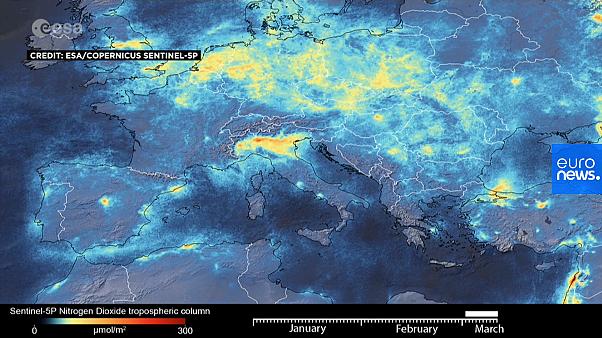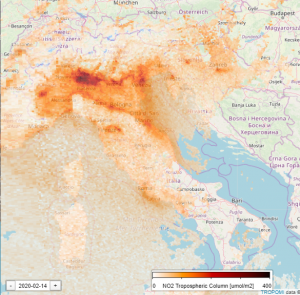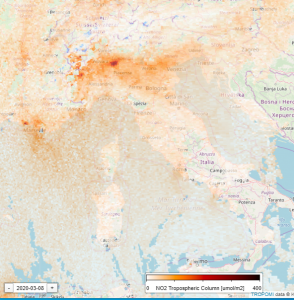
In the following weeks, as an information network devoted to sustainability, we will try to look at current coronavirus outbreak from an economic perspective, to implement and offer an analysis on good practices that shall be implemented as soon as the direct emergency ends. We want to dedicate our effort to all the victims and families deeply damaged by the pandemic, as well as all the people that are constantly working to save lives.
Bitterly, economists might serve under these situations to read the present for assessing and try to prevent future damages. We intend to serve in this purpose with all due respect.
Since over three months ago, Cina has been affected by a virus that overstepped Asiatic borders and arrived in Europe within a few weeks.
The “deadlock” of the country provoked a slowing down in transports and economic sectors such as flying, logistics, commercial distribution etc. As a result, environment was affected in a positive way. In fact, experts noticed a decrease in GHGs emission by 25%, something never happened before in China, an overpopulated country that is still highly dependent on coal as primary energy source.
According to the Climate Index Risk, 500,000 victims have been caused by meteorological effects exacerbated by climate change. Moreover, World Health Organization states that deaths will increase, reaching 250,000 per year. The scenario seems apocalyptic, yet the choices of national governments do not reflect serious concerns (for example, only a few countries in the world had a clear transition to renewable energy). Particularly, governments’ measures taken to face climate change cannot be compared to those concerning the virus. This can be explained by the assumption that people’s adversity of risk is higher for Covid-19 than climate change.
Giovanni Carrosio, professor at the University of Trieste, tried to explain the irrationality of risk by comparing travelling by car with travelling by plane. Rationally, the latter transport would be safer, and yet most people prefer the former one. Actually, the probability of dying by car is 1 over 103, while the likelihood of a person to die by plane is 1 over 188,364.
For what concerns COVID-19 outbreak in Italy, Doctor Milena Gabanelli’s Dataroom outlined the short-term situation, having most data explicitly covered. ASPI data outlined an 18% reduction in highway traffic (-20% light car traffic, +2% heavy truck traffic). School and business closure have also caused a reduction in CO2 emissions, as well as airline traffic reduction. Air currents did also play a role in reducing CO2 presence in the atmosphere surrounding Italy. All these events caused, in the short term, a reduction in CO2 by 428,000 tons in the three regions most affected by COVID-19. This numbers only reflect the first week and will exponentially grow as long as these restrictive measures are kept. These measures must be analyzed in the long term to have scientific relevance, and we will do so as soon as AQI, ISPRA and ARPA data will be updated. Only time will mutate collective perception into real consequences.
On the other side, it must be acknowledged that Human and Economic costs will be monstrous. We state this to clarify that the data on CO2 reduction, and consequent social welfare increase, will be analyzed only as an empiric opportunity to evaluate smart working policies, shorter supply chains. A model that we should aim in reaching as soon as this emergency will end. We say this by remembering that any economic assessment of human health, in particular Value of Statistical Life (VOSL), takes health into account related to human productivity. Restrictive measures that prevent the citizen from working or going to school undermine any evaluation attempt.
In the next article, to keep following COVID-19 outbreak consequences, we will assess “positive” CO2-health related changes that in the long term might affect workers’ and citizens’ life. The data that we are taking into account comprehend PM10, PM 2.5 and NO2 in the atmosphere.
Useful Links for insights:
Milena Gabbanelli, Coronavirus ed emission di CO2, l’aria è più pulita ma non è una buona notizia: perchè? https://www.corriere.it/dataroom-milena-gabanelli/coronavirus-ed-emissioni-co2-l-aria-piu-pulita-ma-non-buona-notizia-perche/3f1d4156-62d6-11ea-a693-c7191bf8b498-va.shtml
Jonathan Watts, Coronavirus could cause fall in global CO2 emissions. Responses to utbreak also show how governemtn policy and behavioural changes can have impact https://www.theguardian.com/world/2020/mar/10/coronavirus-could-cause-fall-in-global-co2-emissions
Video:
Minute Earth, How Do Greenhouse Gases Actually Work https://www.youtube.com/watch?v=sTvqIijqvTg
Database:
ARPA Lombardia https://www.arpalombardia.it/Pages/Ricerca-Dati-ed-Indicatori.aspx
World Air Quality Index Project https://aqicn.org/city




